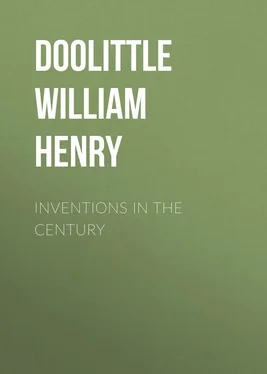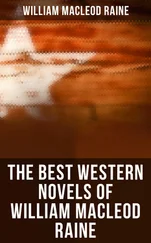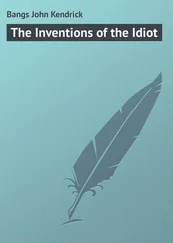William Doolittle - Inventions in the Century
Здесь есть возможность читать онлайн «William Doolittle - Inventions in the Century» — ознакомительный отрывок электронной книги совершенно бесплатно, а после прочтения отрывка купить полную версию. В некоторых случаях можно слушать аудио, скачать через торрент в формате fb2 и присутствует краткое содержание. Жанр: foreign_antique, foreign_prose, на английском языке. Описание произведения, (предисловие) а так же отзывы посетителей доступны на портале библиотеки ЛибКат.
- Название:Inventions in the Century
- Автор:
- Жанр:
- Год:неизвестен
- ISBN:нет данных
- Рейтинг книги:5 / 5. Голосов: 1
-
Избранное:Добавить в избранное
- Отзывы:
-
Ваша оценка:
- 100
- 1
- 2
- 3
- 4
- 5
Inventions in the Century: краткое содержание, описание и аннотация
Предлагаем к чтению аннотацию, описание, краткое содержание или предисловие (зависит от того, что написал сам автор книги «Inventions in the Century»). Если вы не нашли необходимую информацию о книге — напишите в комментариях, мы постараемся отыскать её.
Inventions in the Century — читать онлайн ознакомительный отрывок
Ниже представлен текст книги, разбитый по страницам. Система сохранения места последней прочитанной страницы, позволяет с удобством читать онлайн бесплатно книгу «Inventions in the Century», без необходимости каждый раз заново искать на чём Вы остановились. Поставьте закладку, и сможете в любой момент перейти на страницу, на которой закончили чтение.
Интервал:
Закладка:
In this unfolding of the wonders of chemistry in the nineteenth century, the old empirical walls between forces and organisms, and organic and inorganic chemistry, are breaking down, and celestial and terrestrial bodies and vapours, living beings, and growing plants are discovered to be the evolution of one all-pervading essence and force. One is reminded of the lines of Tennyson:
"Large elements in order brought
And tracts of calm from tempest made,
And world fluctuation swayed
In vassal tides that followed thought.
One God, one law, one element,
And one far-off divine event
To which the whole creation moves."
In the class of alcohol and in the field of yeast, the work of Pasteur, begun in France, has been followed by improvements in methods for selecting proper ferments and excluding improper ones, and in improved processes for aging and preserving alcoholic liquors by destroying deleterious ferments. Takamine, in using as ferment, koji, motu and moyashi, different forms of mould, and proposing to do entirely away with malt in the manufacture of beer and whiskey, has made a noteworthy departure. Manufacturing of malt by the pneumatic process, and stirring malt during germination, are among the improvements.
Carbonating. – The injecting of carbonic acid gas into various waters to render them wholesome, and also into beers and wines during fermentation, and to save delay and prevent impurities, are decided improvements.
The immense improvements and discoveries in the character of soils and fertilisers have already been alluded to. Hundreds of instruments have been invented for measuring, analysing, weighing, separating, volatilising and otherwise applying chemical processes to practical purposes.
To the chemistry of the century the world is indebted for those devices and processes for the utilisation and manufacture of many useful products from the liquids and oils, sugar from cane and beets, revivifying bone-black, centrifugal machinery for refining sugar, in defecating it by chemicals and heat, in evaporating it in pans, in separating starch and converting it into glucose, etc.
Oils and Fats. – Up to within this century the vast amount of cotton seed produced with that crop was a waste. Then by the process, first of steaming the seed and expressing the oil, now by the process of extraction by the aid of volatile solvents, and casting off the solvents by distillation, an immensely valuable product has been obtained.
The utilising of oils in the manufacture of oilcloth and linoleum and rubber, has become of great commercial value. Formerly sulphur was the vulcanising agent, now chloride of sulphur has been substituted for pure sulphur.
Steam and the distillation processes have been applied with great success to the making of glycerine from fat and from soap underlye and in extracting fat from various waste products.
Bleaching and Dyeing. – Of course these arts are very old, but the old methods would not be recognised in the modern processes; and those who lived before the century knew nothing of the magnificent colours, and certain essences, and sweet savours that can be obtained from the black, hand-soiling pieces of coal. In the making of illuminating gas, itself a finished chemical product of the century, a vast amount of once wasted products, especially coal tar, are now extensively used; and from coal tar and the residuum of petroleum oils, now come those splendid aniline dyes which have produced such a revolution in the world of colours. The saturation of sand by a dye and its application to fabrics by an air blast; the circulation of the fluid colors, or of fluids for bleaching or drying, or oxidising, through perforated cylinders or cops on which the cloths are wound; devices for the running of skeins through dyes, the great improvements in carbon dyes and kindred colours, the processes of making the colours on the fibre, and the perfumes made by the synthetic processes, are among the inventions in this field.
The space that a list of the new chemical products of this age and their description would fill, has already been indicated by reference to the great dictionary of Watts. Some of the electro-chemical products will be hereinafter referred to in the Chapter on Electricity, and the chemistry of Metallurgy will be treated under the latter topic.
Electro-chemical Methods. – Space will only permit it to be said that these methods are now employed in the production of a large number of elements, by means of which very many of them which were before mere laboratory specimens, have now become cheap and useful servants of mankind in a hundred different ways; such as aluminium, that light and non-corrosive metal, reduced from many dollars an ounce a generation ago, to 30 and 40 cents a pound now; carborundum, largely superseding emery and diamond dust as an abradant; artificial diamonds; calcium carbide, from which the new illuminating acetylene gas is made; disinfectants of many kinds; pigments, chromium, manganese, and chlorates by the thousand tons. The most useful new chemical processes are those used in purifying water sewage and milk, in electroplating metals and other substances, in the application of chemicals to the fine arts, in extracting grease from wool, and the making of many useful products from the waste materials of the dumps and garbage banks.
Medicines and Surgery. – One hundred years ago, the practice of medicine was, in the main, empirical. Certain effects were known to usually follow the giving of certain drugs, or the application of certain measures, but why or how these effects were produced, was unknown. The great steps forward have been made upon the true scientific foundation established by the discoveries and inventions in the fields of physics, chemistry and biology. The discovery of anaesthetics and their application in surgery and the practice of medicine, no doubt constitutes the leading invention of the century in this field.
Sir Humphry Davy suggested it in 1800, and Dr. W. T. Morton was the first to apply an anaesthetic to relieve pain in a surgical operation, which he did in a hospital in Boston in 1846. Both its original suggestion and application were also claimed by others.
Not only relief from intense pain to the patient during the operation, but immense advantages are gained by the long and careful examination afforded of injured or diseased parts, otherwise difficult or impossible in a conscious patient.
The exquisite pain and suffering endured previous to the use of anaesthetics often caused death by exhaustion. Many delicate operations can now be performed for the relief of long-continued diseases which before would have been hazardous or impossible. How many before suffered unto death long-drawn-out pain and disease rather than submit to the torture of the knife! How many lives have been saved, and how far advanced has become the knowledge of the human body and its painful diseases, by this beneficent remedy!
Inventions in the field of medicine consist chiefly in those innumerable compositions and compounds which have resulted from chemical discoveries. Gelatine capsules used to conceal unpalatable remedies may be mentioned as a most acceptable modern invention in this class. Inventions and discoveries in the field of surgery relate not only to instrumentalities but processes. The antiseptic treatment of wounds, by which the long and exhausting suppuration is avoided, is among the most notable of the latter. In instruments vast improvements have been made; special forms adapted for operation in every form of injury; in syringes, especially hypodermic, those used for subcutaneous injections of liquid remedies; inhalers for applying medicated vapours and devices for applying volatile anaesthetics, and devices for atomising and spraying liquids. In the United States alone about four thousand patents have been granted for inventions in surgical instruments.
Читать дальшеИнтервал:
Закладка:
Похожие книги на «Inventions in the Century»
Представляем Вашему вниманию похожие книги на «Inventions in the Century» списком для выбора. Мы отобрали схожую по названию и смыслу литературу в надежде предоставить читателям больше вариантов отыскать новые, интересные, ещё непрочитанные произведения.
Обсуждение, отзывы о книге «Inventions in the Century» и просто собственные мнения читателей. Оставьте ваши комментарии, напишите, что Вы думаете о произведении, его смысле или главных героях. Укажите что конкретно понравилось, а что нет, и почему Вы так считаете.












